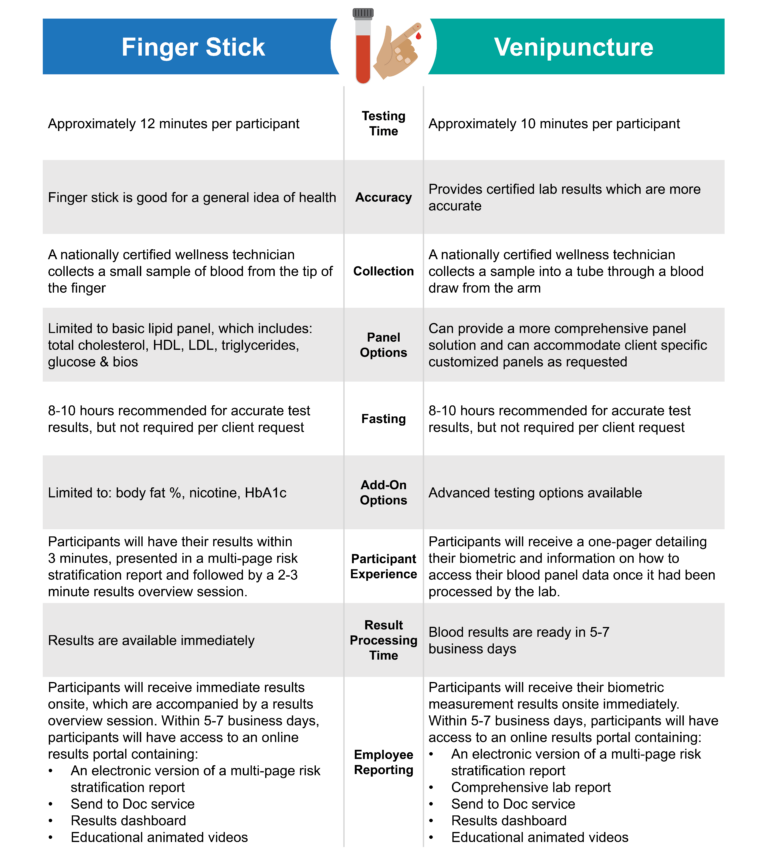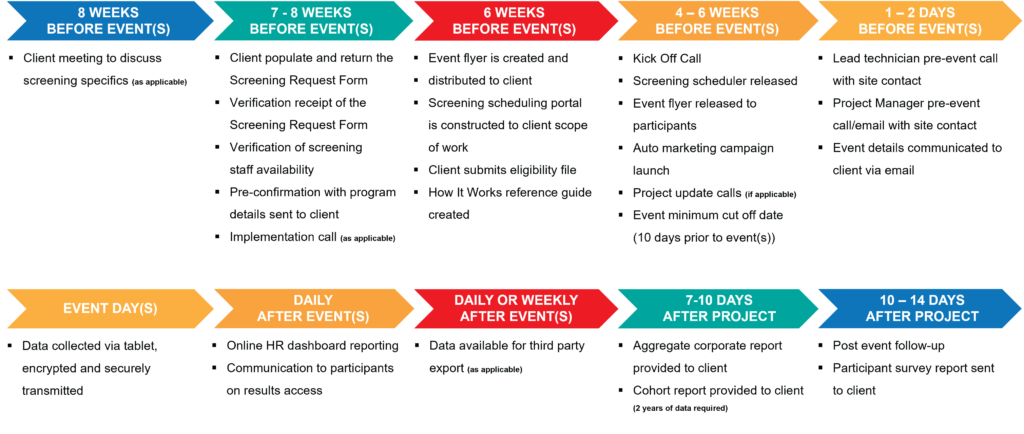
Whether you’re building a strategy to lower your organization’s healthcare spending or just looking to stay up-to-date on your workforce’s wellbeing, biometric health screenings can be an effective tool for getting your employees engaged with their health. But before making the investment, it’s important to build foundational knowledge around what biometric screenings are, how they work, and how to get your people engaged with them. In this blog we’ll answer some of our clients’ most frequently asked questions about biometric screenings to help you plan your next biometric screening event.
Let’s start with the most basic question.
What is a biometric health screening and what is it used for?
A biometric health screening is a short health exam that measures several health indicators, including blood pressure, glucose levels, lipids, waist circumference, and body mass index to name a few. The process of gathering vital data on an individual’s health risk factors can then be used to provide recommendations or referrals to health improvement programs.
Typically, corporate wellness programs begin with a biometric health screening to determine an individual’s health risk factors and baseline. With this data, the organization can make referrals to appropriate health improvement programs, then evaluate the effectiveness of those wellness program interventions over time.
Consider this: An employee at a large manufacturing company attends a biometric screening event hosted by their organization. The bloodwork done at this event shows an A1C of 5.9%, indicating prediabetes. However, the employee isn’t left to manage this new challenge all alone: They also get recommendations from their organization’s wellness partner that appointments with a wellness coach are available to help them make the lifestyle changes needed to get back on track.
As a result, the employee gets one-on-one coaching, learns new methods for improving their nutrition and exercise, lowers their A1C, and avoids the costly treatment that a diabetes diagnosis can include. At their next biometric screening, their A1C is back where it needs to be. It’s a win for employees and their organization, all thanks to proactive screening.
As an employer, why should I offer screenings to my employees?
Health and wellness screenings allow employers to get a better sense of their employees’ health and overall wellness needs and allow employees to stay aware of potential risks to their health.
More than 85% of healthcare spending goes to chronic condition care. Because biometric health screenings can help identify conditions early, they give employees the opportunity to take preventative measures and companies runway to leverage their wellness programming for intervention. This can help employers save money by getting ahead of costly conditions, as well as creating a culture of health and productivity among their workforce.
Finger stick or venipuncture – which method of testing is more effective for a biometric screening?
Both methodologies have their advantages, and the decision should be based on the organization’s data needs and overarching wellness objectives. In the end, the best test is the one that generates the most employee engagement and provides employers with the greatest amount of actionable data.
Here are a few key differences:
- Fingerstick tests are less invasive, quicker to administer, require less blood, and results are available almost immediately since they don’t require sending the sample to a laboratory for processing.
- Venipuncture is perceived as slightly more invasive, and it takes 2-5 business days to get processed by the laboratory. It is, however, backed by a certified reference lab and allows for a more comprehensive panel.
Here’s a simple side-by-side comparison:

What does the onsite biometric screening experience look like for participants?
The keys to successfully getting employees engaged with biometric screenings are making communications accessible and providing plenty of touchpoints for education on why and how screenings are important.
For example, an initial event marketing email and flyer are sent to the eligible population, including a link to an animated educational video about the benefits of biometric health screenings, step-by-step instructions for the program, and a QR code that makes it easy to sign up. This information can also be shared via other internal communication channels like an intranet or through a more targeted email marketing campaign. Participants can register online via smartphone, tablet, or PC or telephonically – whichever way works best for them.
On the day of the onsite event, participants check in at a registration table at the time of their scheduled appointment. At the screening station, the wellness technician greets the participant, takes biometric measurements, and draws blood for them.
If the employee gets a finger stick screening, they’ll receive a My Health Profile booklet that includes their biometrics and blood results on the day of their test.
For a venipuncture blood draw, the sample will be sent to the lab for processing. Within three to five business days, participants will receive access to an online results portal containing an electronic copy of the My Health Profile and lab report. Results will be sent to their designated PCP service, and participants can always view results dashboard report and educational animated videos per tested category.
What biometric health screening modality options are available?
With many companies transitioning to a work-from-home or flexible office schedule, the need for more than just onsite screening services has increased. To ensure coverage is available for employees located in any city within the United States (including Alaska and Hawaii) we offer four convenient and effective screening modalities for employers to incorporate into their screening program.

How long does it take to implement a biometric screening solution?
The timeline for implementing onsite biometric screening is typically between six and eight weeks, while offsite options may be implemented in as little as two weeks. Upon request and availability, shorter windows can be accommodated.
You can see a sample implementation timeline below:

Ready to bring biometric screening events and a culture of wellbeing to your organization? Contact us to find out how we can help your employees better understand their own health through biometric screenings and to request a full copy of our frequently asked questions.
